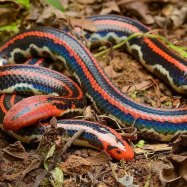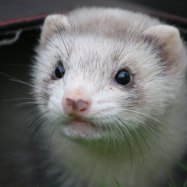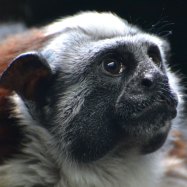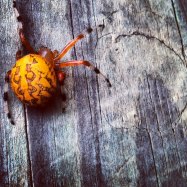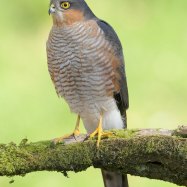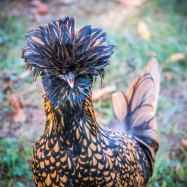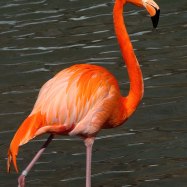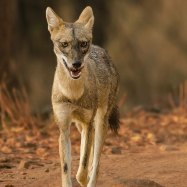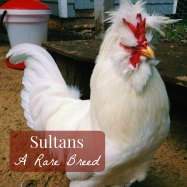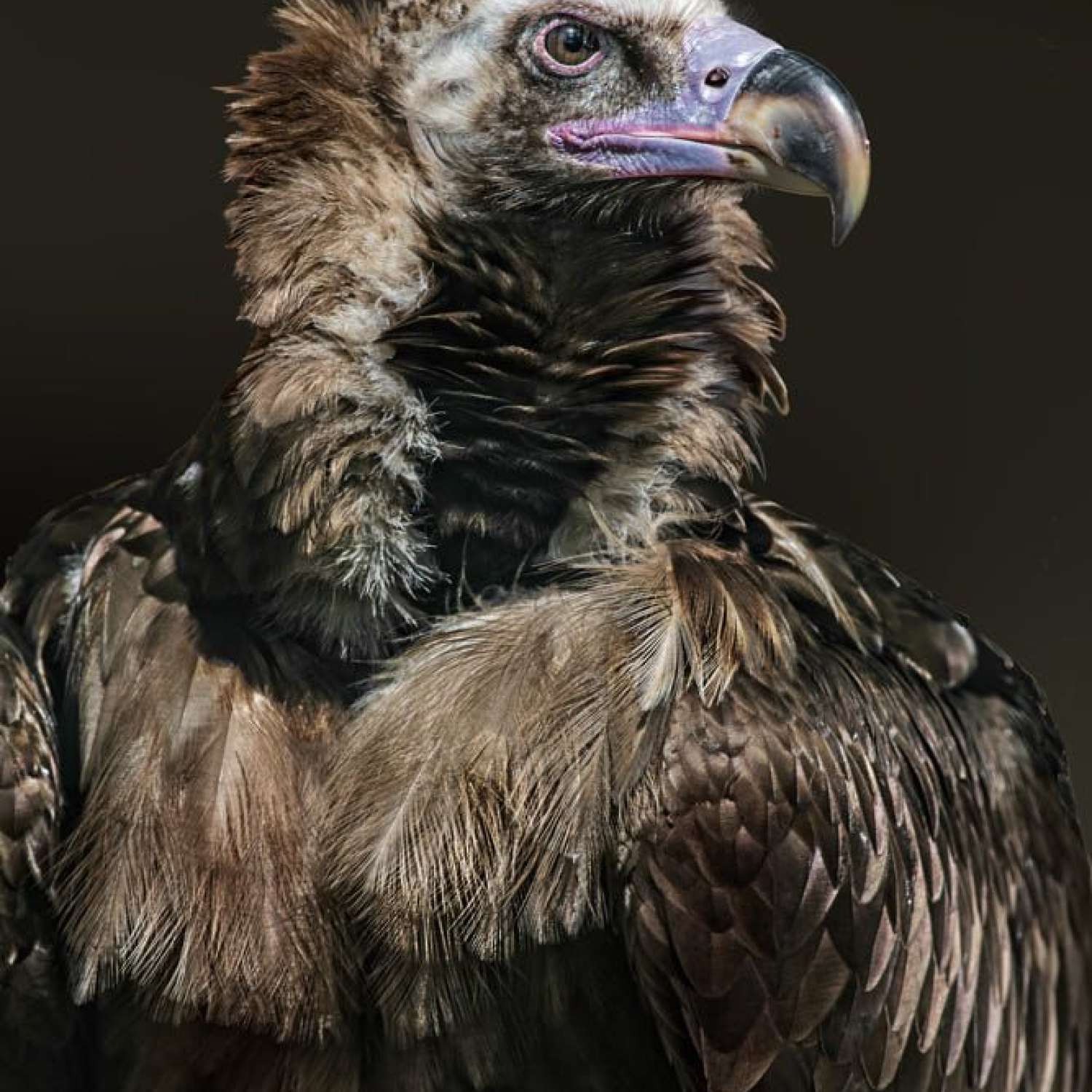
Cinereous Vulture
42 to 52 inches
The Cinereous Vulture, also known as the Eurasian Black Vulture, is a majestic bird with a wingspan of up to 9 feet. Found in a wide range of habitats including forests, mountains, and grasslands, this vulture is a member of the Accipitridae family. With a length of 42 to 52 inches, it is one of the largest and heaviest birds of prey in the world. Learn more about this impressive bird and its role in the ecosystem. #CinereousVulture #BirdsOfPrey #Accipitridae #Ecosystem
Animal Details Summary:
Common Name: Cinereous Vulture
Kingdom: Animalia
Habitat: Mountainous regions, open steppes, and grasslands
The Mighty Cinereous Vulture: The Largest Bird of Prey in Europe, Asia, and Africa
As I wandered through the rugged, mountainous regions of Europe, I was suddenly startled by the sound of powerful wings slicing through the air. My gaze followed the silhouette of a dark, massive bird soaring above me, its wingspan stretching nearly 9 feet. It was a Cinereous Vulture, one of the most impressive and majestic creatures I have ever encountered in the wild.The Cinereous Vulture, or Aegypius monachus, is the largest bird of prey in Europe, Asia, and Africa Cinereous Vulture. Its common name, Cinereous, comes from the Latin word “cinereus,” meaning “ashes” or “gray,” which perfectly describes its dark brown to black plumage with grayish-white feathers. This impressive bird belongs to the Accipitridae family and is part of the same order as hawks, eagles, and kites – the Accipitriformes.
The Mighty Appearance of the Cinereous Vulture
The Cinereous Vulture is a sight to behold, not just because of its impressive size, but also because of its intimidating and majestic appearance. The bird has a large and heavy build, with strong, powerful feet and sharp talons. It can weigh up to 28 pounds and reaches a length of 42 to 52 inches. However, the most striking feature of this bird is its extraordinary wingspan, which can reach up to 9 feet, making it one of the largest flying birds in the world.Despite its size, the Cinereous Vulture is a skilled and agile flyer, using its broad and powerful wings to soar high in the sky for hours without flapping. Its long, broad wings are essential for gliding and soaring, as they help the bird conserve energy while flying over long distances in search of food.
The Habitat of the Mighty Bird
The Cinereous Vulture is found in a variety of habitats, including mountainous regions, open steppes, and grasslands Ceratosaurus. It is a highly adaptable bird and can survive in a wide range of environments, from humid and tropical forests to barren, arid landscapes. This versatility, coupled with its impressive wingspan, allows the Cinereous Vulture to cover a vast territory, making it the most extensive-ranging bird in the Old World.This magnificent bird is native to Europe, Asia, and parts of Africa. It is most commonly found in Spain, Kazakhstan, and Mongolia, where it inhabits remote and mountainous regions. However, it also has a wide distribution range, scattered across various countries in Europe, Asia, and Africa. From Russia to Turkey, from India to Iran, the Cinereous Vulture has made its home in many different countries, surviving and thriving in diverse environments.
The Feeding Habits of the Cinereous Vulture
The Cinereous Vulture is a scavenger, and its feeding habits have earned it the nickname “nature's clean-up crew.” Unlike other birds of prey that hunt live prey, the Cinereous Vulture feeds on carrion and carcasses. Its powerful beak and sharp talons allow it to rip through the tough hide of dead animals, making it an efficient scavenger.For centuries, humans have relied on the Cinereous Vulture to keep their surroundings clean by disposing of animal carcasses that would otherwise spread disease and cause health hazards. Unfortunately, due to the decline in animal population and changes in farming practices, the Cinereous Vulture's main source of food has decreased, putting this magnificent bird at risk. However, conservation efforts and initiatives such as vulture restaurants – places where farmers can legally dispose of livestock carcasses – have helped increase the Cinereous Vulture's population.
The Threats to the Mighty Cinereous Vulture
Like many other species, the Cinereous Vulture faces several threats that put it at risk of extinction. One of the most significant threats to this bird is poisoning. Vultures are often intentionally poisoned by farmers who see them as a threat to their livestock. However, vultures play a crucial role in the ecosystem by preventing the spread of diseases, making their decline a significant concern.Another threat to the Cinereous Vulture is habitat loss. As human populations increase and expand, vital habitats for this large bird are destroyed and fragmented, leading to a decline in their numbers. Though the Cinereous Vulture has a wide distribution range, their populations are scattered and isolated, making it challenging to maintain a healthy and stable population.
Conservation Efforts for the Mighty Bird
Thankfully, the Cinereous Vulture has caught the attention of conservationists and governments, and significant efforts are being made to protect this species. In 2015, the Cinereous Vulture was listed as “Near Threatened” on the International Union for Conservation of Nature (IUCN) Red List, indicating that it is at risk of extinction but still has a chance to recover.Many conservation organizations have focused their efforts on raising awareness about the importance of vultures and the threats they face. They also work on reducing poisonings and protecting crucial habitats for vultures. In addition, captive breeding and reintroduction programs have been successful in increasing the population of the Cinereous Vulture in certain areas.
The Cinereous Vulture: An Important Symbol in Different Cultures
Throughout history, vultures have been a part of many cultures and have been viewed with both fear and admiration. In Egyptian mythology, the vulture is a symbol of motherhood and fertility, while in Greek mythology, it is seen as a symbol of strength and ferocity. In many Native American cultures, the vulture is regarded as a symbol of rebirth and renewal.In Mongolia, the Cinereous Vulture holds a special place in the culture of the Kazakh nomadic shepherds. They believe that the spirit of their ancestors lives on in the vultures, and they give them a ceremonial burial when they die. This unique relationship between the Kazakh community and the Cinereous Vulture highlights the bird's significance and cultural value.
The Impact of NLP on Vulture Conservation
With the advancements in technology and Natural Language Processing (NLP), the fight for vulture conservation has gained a new and powerful tool. NLP is a branch of Artificial Intelligence that enables computers to understand and interpret human language. NLP algorithms can analyze large amounts of text data and provide insights that humans might not have noticed.The use of NLP in vulture conservation has proven to be effective, as it helps researchers analyze data and track human activity that affects vultures. For example, NLP algorithms can detect patterns of illegal poisoning by mining information from social media and news articles. This information then helps conservation organizations and authorities take action and prevent further harm to the vulture population.
NLP has also played a crucial role in raising awareness about the importance of vultures and their plight. With the help of social media and other digital platforms, conservation organizations can reach a wider audience and educate the public about the threats facing vultures. Using NLP, they can also monitor the public's attitude towards vultures and measure the impact of their awareness campaigns.
In Conclusion
The Cinereous Vulture is truly a remarkable and majestic creature, with a vital role to play in our ecosystem. From its impressive size and appearance to its important cultural significance, this bird is one that demands our attention and protection. With continued efforts to conserve their habitats, reduce poisonings, and raise awareness, we can ensure that the Cinereous Vulture continues to soar high in the sky for generations to come. So next time you see this mighty bird soaring above, take a moment to appreciate its beauty and remember the vital role it plays in our world.

Cinereous Vulture
Animal Details Cinereous Vulture - Scientific Name: Aegypius monachus
- Category: Animals C
- Scientific Name: Aegypius monachus
- Common Name: Cinereous Vulture
- Kingdom: Animalia
- Phylum: Chordata
- Class: Aves
- Order: Accipitriformes
- Family: Accipitridae
- Habitat: Mountainous regions, open steppes, and grasslands
- Feeding Method: Scavenger
- Geographical Distribution: Europe, Asia, and parts of Africa
- Country of Origin: Various countries across the distribution range
- Location: Wide range of habitats including forests, mountains, and grasslands
- Animal Coloration: Dark brown to black with grayish-white plumage
- Body Shape: Large and heavy-bodied with a wingspan of up to 9 feet
- Length: 42 to 52 inches
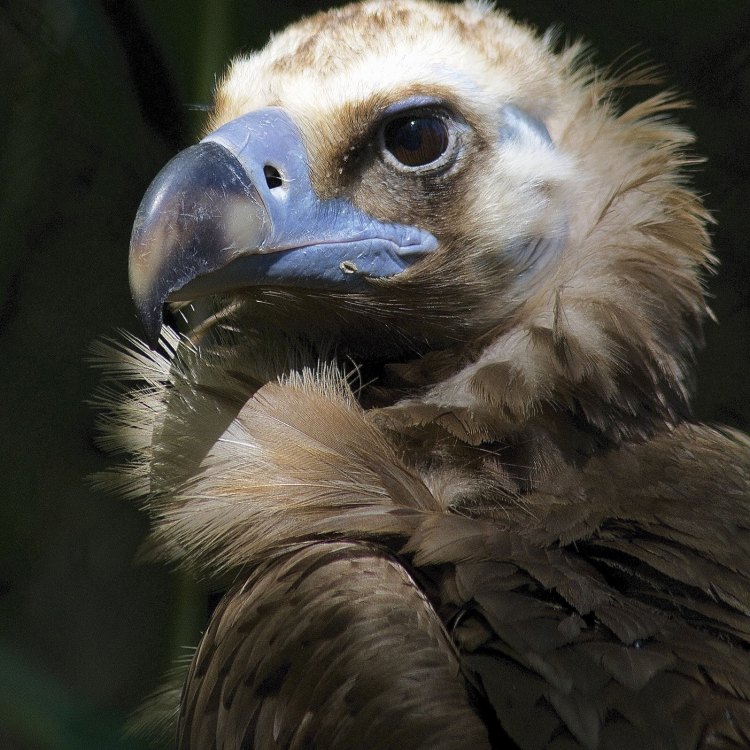
Cinereous Vulture
- Adult Size: Adults weigh between 15 and 25 pounds
- Average Lifespan: Up to 30 years in the wild
- Reproduction: Sexual
- Reproductive Behavior: Monogamous
- Sound or Call: Hoarse cawing sounds
- Migration Pattern: Partial migratory, with some populations being sedentary
- Social Groups: Solitary or small groups
- Behavior: Mainly a scavenger, feeding on carrion
- Threats: Habitat loss, poisoning from lead ammunition, collision with power lines, and food scarcity
- Conservation Status: Near Threatened
- Impact on Ecosystem: Important role in maintaining ecosystem health by cleaning up carcasses
- Human Use: In some cultures, parts of the Cinereous Vulture are used for medicinal purposes or as talismans
- Distinctive Features: Large size, massive bill, wedge-shaped tail, and feathered head
- Interesting Facts: One of the largest vulture species in the world, they have been recorded flying at altitudes of over 6,000 meters (19,700 feet)
- Predator: No known natural predators for adult Cinereous Vultures
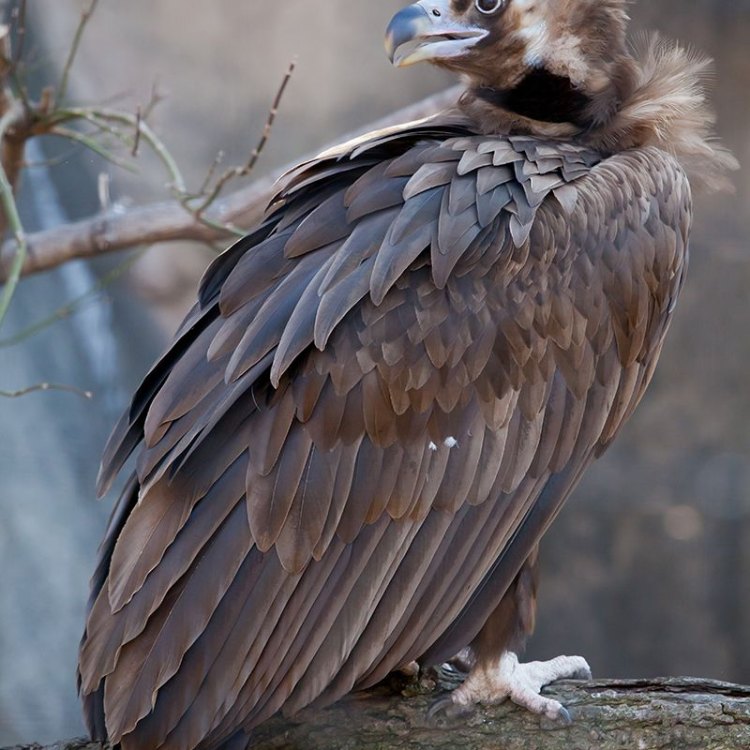
Aegypius monachus
The Mighty Cinereous Vulture: A Regal and Essential Predator
In the vast and diverse world of birds, the Cinereous Vulture stands out with its massive size and impressive features. Also known as the Eurasian Black Vulture or the Monk Vulture, this magnificent bird inhabits a large part of Europe and Asia, making it an important and recognizable predator in the ecosystem.With an adult size ranging between 15 and 25 pounds, these majestic birds are one of the largest vulture species in the world. Their imposing size is further accentuated by their striking features, including a massive bill, a wedge-shaped tail, and a feathered head PeaceOfAnimals.Com. These distinguishing characteristics make the Cinereous Vulture an unmistakable sight in the wild.
But beyond their appearance, this bird species also holds many other unique qualities that make it a crucial member of its ecosystem. From their reproductive behavior to their impact on the environment, let's delve deeper into the fascinating world of the Cinereous Vulture.
A Regal and Monogamous Reproduction
Like most birds, the Cinereous Vulture is a sexually reproductive species. Their breeding season usually begins in the spring, where they form monogamous pairs that will stay together for the rest of their lives. This means that these birds mate with only one partner, showing remarkable commitment and loyalty.Once a pair has bonded, they construct a large nest on a high cliff or a tall tree, made with branches and other materials. The female will then lay one to three eggs, which both parents will take turns incubating for about 50 days before they hatch. After hatching, the young vultures stay in the nest for about three months, being fed and cared for by their devoted parents Chickadee.
Their strong bond and family values make the Cinereous Vultures truly remarkable creatures, setting an example for monogamy in the animal kingdom.
A Hoarse Caw and Partial Migration
One of the distinctive features of the Cinereous Vulture is its hoarse cawing call, which can be heard up to a mile away. This sound is often used to communicate with their mate and other vultures in the area.Although some populations are sedentary, meaning they do not migrate, many Cinereous Vultures engage in partial migration. This means that they may travel long distances in search of food but usually stay within or near their nesting areas. This behavior is essential for their survival, as it allows them to find new food sources as their primary food supply, carrion, becomes scarce in some areas.
Solitary or Small Social Groups
Cinereous Vultures are solitary birds, often seen alone or in small groups of around 2-3 vultures. However, during migration season, these groups can grow up to 20 vultures. These birds are known for their soaring abilities, often seen gliding and circling high up in the sky, using thermal currents to conserve energy.While they may not be highly social, the Cinereous Vulture plays a crucial role in maintaining the health of the ecosystem.
A Mainly Scavenging Predator
The Cinereous Vulture is primarily a scavenger, feeding on carrion, or dead animals, such as deer, wild boars, and other small mammals. They have extremely powerful beaks, which they use to rip open skin and tear into meat, making them one of the few bird species capable of digesting large chunks of meat. Their ability to clean up carcasses is essential in preventing the spread of diseases and maintaining ecological balance.Threats to Survival and Conservation Efforts
Sadly, like many animal species, the Cinereous Vulture is facing numerous threats to its survival. Habitat loss, due to human activities such as urbanization and industrialization, is one of the leading causes of their declining population in some regions. As they require large areas of undisturbed land to find food and hunt, their natural habitat is increasingly shrinking.Another significant threat to their survival is poisoning from lead ammunition, which is often used by hunters and can harm vultures who feed on the carcasses of animals shot with lead bullets. The birds can also collide with power lines, causing fatal injuries.
Additionally, food scarcity due to the depletion of carrion sources also poses a significant challenge for the Cinereous Vulture's survival. This is a growing issue in areas where human activities, such as overhunting and illegal poisoning, have reduced the populations of other large animals that are a food source for these birds.
Thankfully, the Cinereous Vulture is listed as Near Threatened on the IUCN Red List, and several conservation efforts are in place to protect and increase their numbers. These include establishing protected areas, educating local communities about the importance of vultures, and alternative hunting practices that do not involve the use of lead ammunition.
Vultures: The Unsung Heroes of the Ecosystem
In many cultures, vultures are often misunderstood and perceived as dirty and ugly birds. However, vultures, including the Cinereous Vulture, play a vital role in maintaining the health of the ecosystem. Their scavenging behavior helps prevent the spread of diseases and ensures that the natural cycle of life and death is maintained.Vultures also play a crucial role in nutrient recycling, as they carry out their duty as nature's recyclers, converting carrion into nutrients that enrich the soil and support the growth of vegetation. This makes them essential to the overall functioning of the ecosystem, highlighting the importance of their conservation.
Humans and the Cinereous Vulture
Humans have a long and complicated relationship with vultures. In some cultures, parts of the Cinereous Vulture are used for medicinal purposes or as talismans. Their feathers are also used in traditional rituals and ceremonies.Furthermore, vultures have been featured in art, literature, and mythology, symbolizing strength, rebirth, and spiritual power. This fascinating connection between humans and the Cinereous Vulture is a testament to the significance of these birds in our history and culture.
However, it is essential to recognize that our actions have a direct impact on these birds and their survival. By understanding and protecting these majestic creatures, we can maintain the balance of our ecosystems and ensure their survival for future generations.
The Mighty Cinereous Vulture: A Bird Worth Protecting
In conclusion, the Cinereous Vulture is a remarkable bird, both in its appearance and its role in the ecosystem. From their monogamous reproduction to their soaring abilities and scavenging behavior, these vultures are a true wonder of nature.But they face numerous threats to their survival, from habitat loss to poisoning and food scarcity. It is our responsibility to take action and protect these magnificent birds, not only for their sake but also for the health of our environment.
So, the next time you see a Cinereous Vulture soaring high in the sky or hear their distinctive hoarse caw, remember the vital role they play in maintaining the balance of our ecosystem. Let us work together to ensure that they continue to thrive and reign as the mighty predators of the skies.
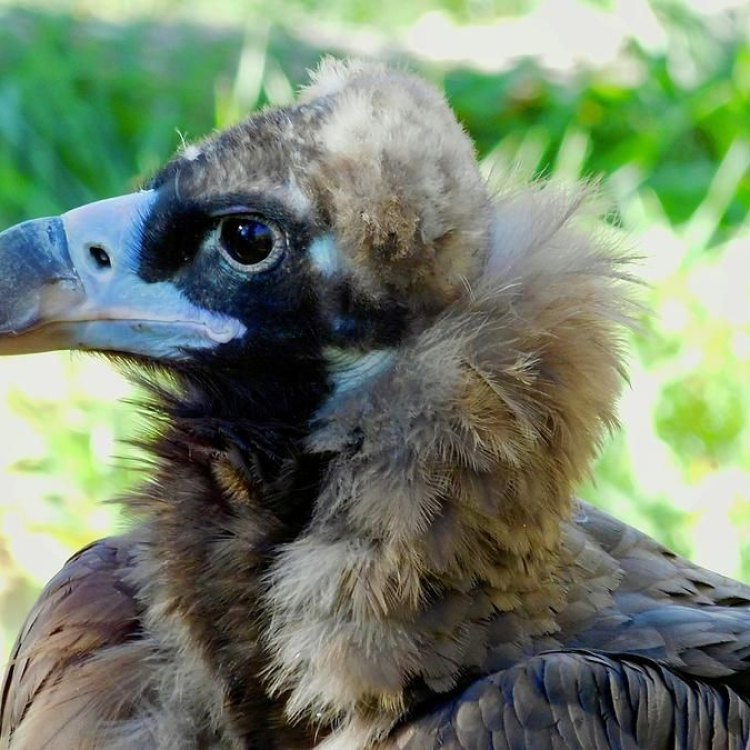
The Mighty Cinereous Vulture: The Largest Bird of Prey in Europe, Asia, and Africa
Disclaimer: The content provided is for informational purposes only. We cannot guarantee the accuracy of the information on this page 100%. All information provided here may change without prior notice.

